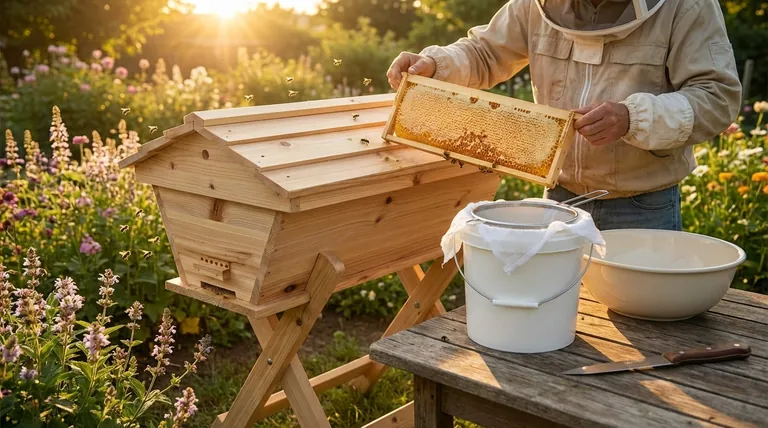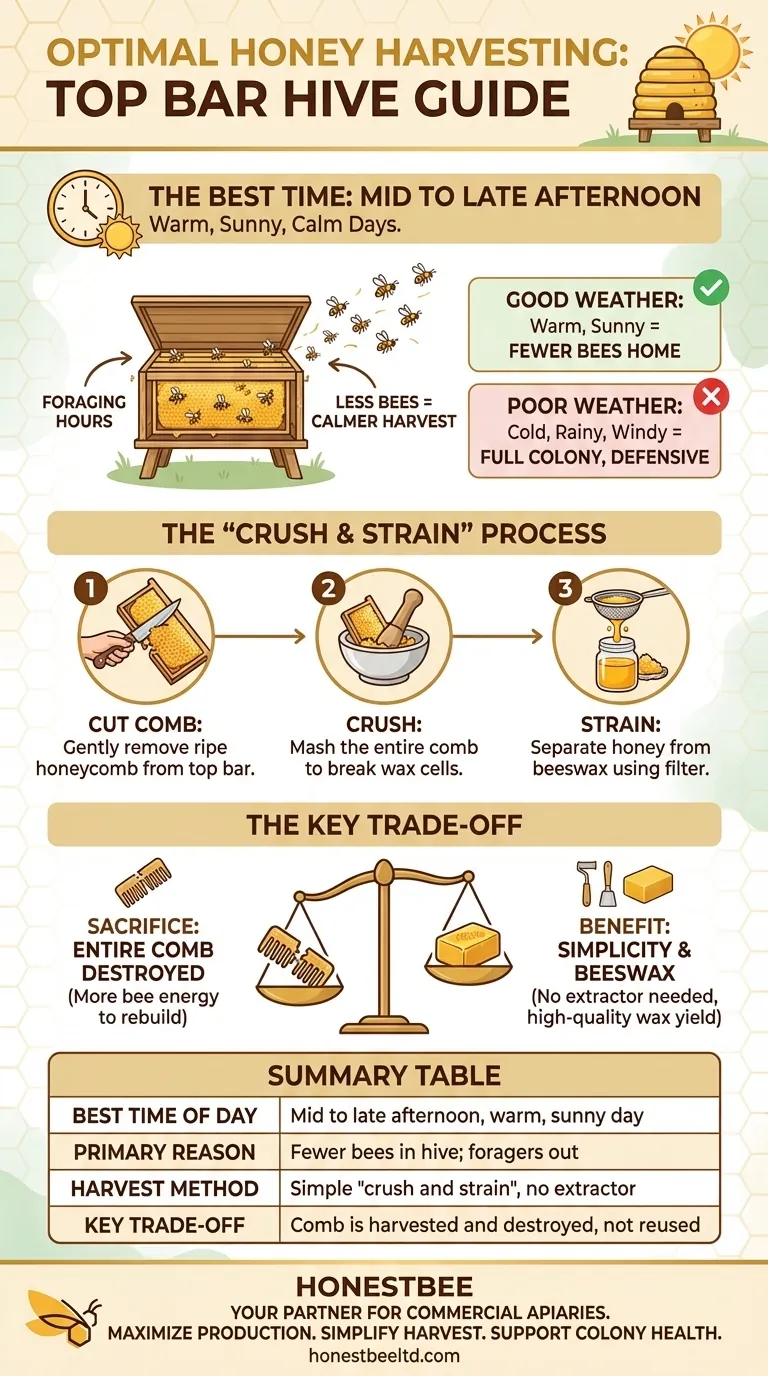The ideal time to harvest honey from a top bar hive is on a warm, sunny, and calm day, specifically in the mid to late afternoon. This timing is strategic, as it aligns with the peak foraging hours of your honey bees. With the majority of the foraging workforce out of the hive collecting nectar and pollen, you will encounter fewer bees, leading to a calmer and less disruptive harvest for both you and the colony.
The core principle is not just about a time of day, but about working in harmony with the bees' natural schedule. By choosing a time when the hive's population is at its lowest, you minimize stress on the colony and create a safer, more efficient experience for the beekeeper.

The Principle: Timing for a Quieter Hive
Harvesting honey is inherently disruptive. Your goal is to manage that disruption effectively. The single most important factor is choosing a time when the fewest bees are home to defend it.
Why Mid-Afternoon is Optimal
During the middle of a productive day, thousands of forager bees are out of the hive. These are typically the older, more experienced bees responsible for defense.
With the primary defensive force away on business, the bees remaining in the hive are generally younger nurse bees, who are more preoccupied with internal tasks and less prone to agitation.
The Importance of Good Weather
Bees will not forage in cold, rainy, or overly windy conditions. Attempting a harvest during poor weather means you will be facing the full strength of the colony, which will be more defensive.
A warm, sunny day encourages maximum foraging activity. However, avoid "terribly" hot days where bees may stay inside to help cool the hive (a behavior known as "bearding"), as this can also increase the population inside.
The Unique Process of Top Bar Harvesting
Unlike frame-based hives like the Langstroth, the top bar hive is designed for a fundamentally different and simpler harvesting process. It does not require expensive or specialized equipment.
Simplicity is the Goal
The entire harvest can be accomplished with basic kitchen tools. You will need a knife to cut the comb, a bucket or large bowl to place it in, and a strainer system to separate the honey from the wax.
This stands in contrast to Langstroth hives, which require a centrifugal honey extractor to remove honey while preserving the drawn-out comb on the frames.
The "Crush and Strain" Method
The process involves gently removing a top bar that contains ripe honey, which is identified by comb that is fully or at least three-quarters capped with wax.
You then cut the entire comb from the top bar, letting it fall into your container. Once all desired combs are collected, they are simply crushed or mashed to break open the wax cells. The resulting mix is then strained, often through cheesecloth or a dedicated filter, letting pure honey drip out.
Understanding the Trade-offs
The simplicity of the top bar harvest comes with a significant trade-off that every beekeeper must understand.
The Cost: Sacrificing the Comb
In a top bar hive, the entire comb is harvested and destroyed in the process. It is not returned to the hive.
This represents a significant energy and resource cost to the colony. Bees must consume a large amount of honey (roughly 8 pounds) to produce just one pound of beeswax. Rebuilding this comb is a major setback that diverts resources away from storing more honey.
The Benefit: Simplicity and Beeswax
The primary benefit is the low barrier to entry and simplicity of the process. You do not need an expensive, bulky extractor.
Furthermore, this method yields a significant quantity of high-quality beeswax. After the honey is strained, the remaining wax can be cleaned and rendered for use in candles, balms, and other valuable products.
Impact on Honey Yield
Because the bees must constantly rebuild comb after each harvest, the total honey production of a top bar hive is generally lower than that of a Langstroth hive where the drawn comb is reused year after year.
Making the Right Choice for Your Beekeeping Goals
Your approach should align with your primary reason for keeping bees.
- If your primary focus is maximum honey production: A top bar hive's destructive harvest method may be less efficient than a frame-based system.
- If your primary focus is a simple, natural approach: The top bar method is ideal, as it avoids complex equipment and provides both honey and valuable beeswax.
- If your primary focus is colony health and a calm harvest: Timing your work for mid-afternoon on a good foraging day is the most critical factor, regardless of hive type.
Ultimately, successful beekeeping means understanding and aligning your actions with the natural rhythms of the colony.
Summary Table:
| Harvest Factor | Key Consideration |
|---|---|
| Best Time of Day | Mid to late afternoon on a warm, sunny day |
| Primary Reason | Fewer bees in the hive; foragers are out collecting nectar |
| Harvest Method | Simple 'crush and strain' process, no extractor needed |
| Key Trade-off | Entire honeycomb is harvested and destroyed, not reused |
Ready to optimize your beekeeping operation?
HONESTBEE is your trusted partner for commercial apiaries and beekeeping equipment distributors. We supply the durable, wholesale-focused supplies you need for efficient and productive hive management.
Let us help you achieve your goals:
- Maximize Honey Production: Equip your operation with reliable tools.
- Simplify Your Harvest: Access equipment designed for efficiency.
- Support Colony Health: Use products built with beekeeping best practices in mind.
Contact our expert team today to discuss your wholesale needs and how we can support your success.
Visual Guide

Related Products
- Top Bar Beehive for Beekeeping Wholesales Kenya Top Bar Hive
- Long Langstroth Style Horizontal Top Bar Hive for Wholesale
- HONESTBEE Professional Multi-Functional Hive Tool with Ergonomic Wood Handle
- HONESTBEE Professional Long Handled Hive Tool with Precision Cutting Blade
- HONESTBEE Advanced Ergonomic Stainless Steel Hive Tool for Beekeeping
People Also Ask
- Which is better Kenya top bar hive or Langstroth? Choose the Right Hive for Your Goals
- How is honey harvested from a top-bar hive? A Guide to Simple, Low-Equipment Processing
- What are the labor requirements for a KTBH vs. Langstroth hive? A Guide for Apiary Efficiency
- Why are hive inspections easier with Top Bar Hives? Achieve a Calmer, Safer Approach to Beekeeping
- What are the advantages of harvesting honey from a top bar hive? Low-Cost, Simple Harvesting for Beekeepers



















